Professional Skills Report: Conflict Management and Servant Leadership
VerifiedAdded on 2020/12/10
|7
|1964
|67
Report
AI Summary
This report provides a detailed analysis of a case study involving a sales team facing various professional challenges. The introduction highlights the importance of skilled management and employee motivation in achieving organizational goals. Task 1 identifies the problems within the sales team, including conflicts between top performers, health issues affecting performance, and communication gaps. The causes of conflict, such as lack of guidance and team spirit, are examined, along with precautions like improved interpersonal relations and feedback mechanisms to mitigate these issues. The report also discusses organizational situations like conflict management, motivation, and negotiation skills. Task 2 focuses on servant leadership, defining its principles like giving value, building community, and providing leadership. It then explores how these principles can be implemented to address the case study's challenges, emphasizing empathy, listening, and awareness. The conclusion reiterates the significance of professionalism in fostering a healthy work environment and suggests practical strategies for conflict resolution and effective leadership within the organization. The report utilizes references to support the analysis and recommendations.
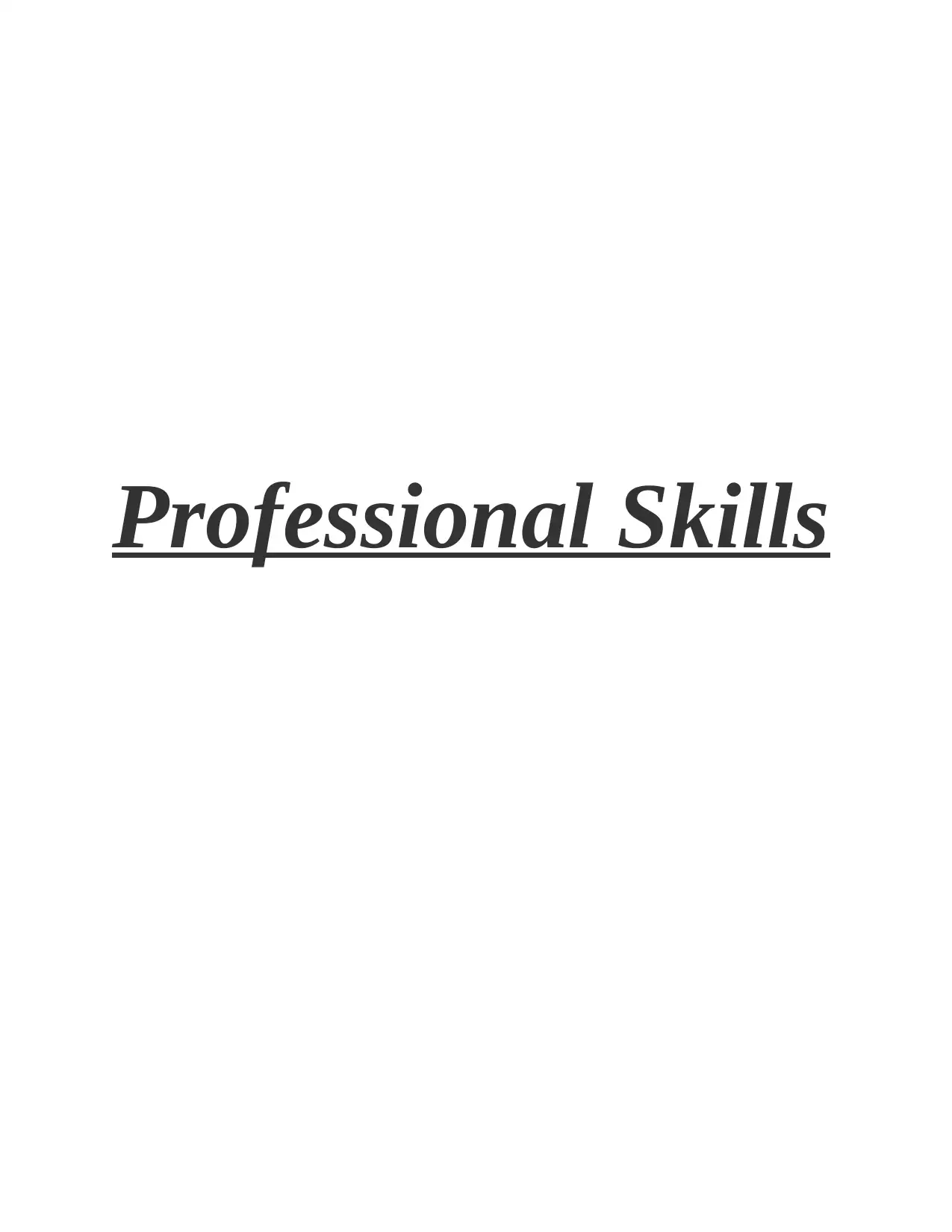
Professional Skills
Paraphrase This Document
Need a fresh take? Get an instant paraphrase of this document with our AI Paraphraser
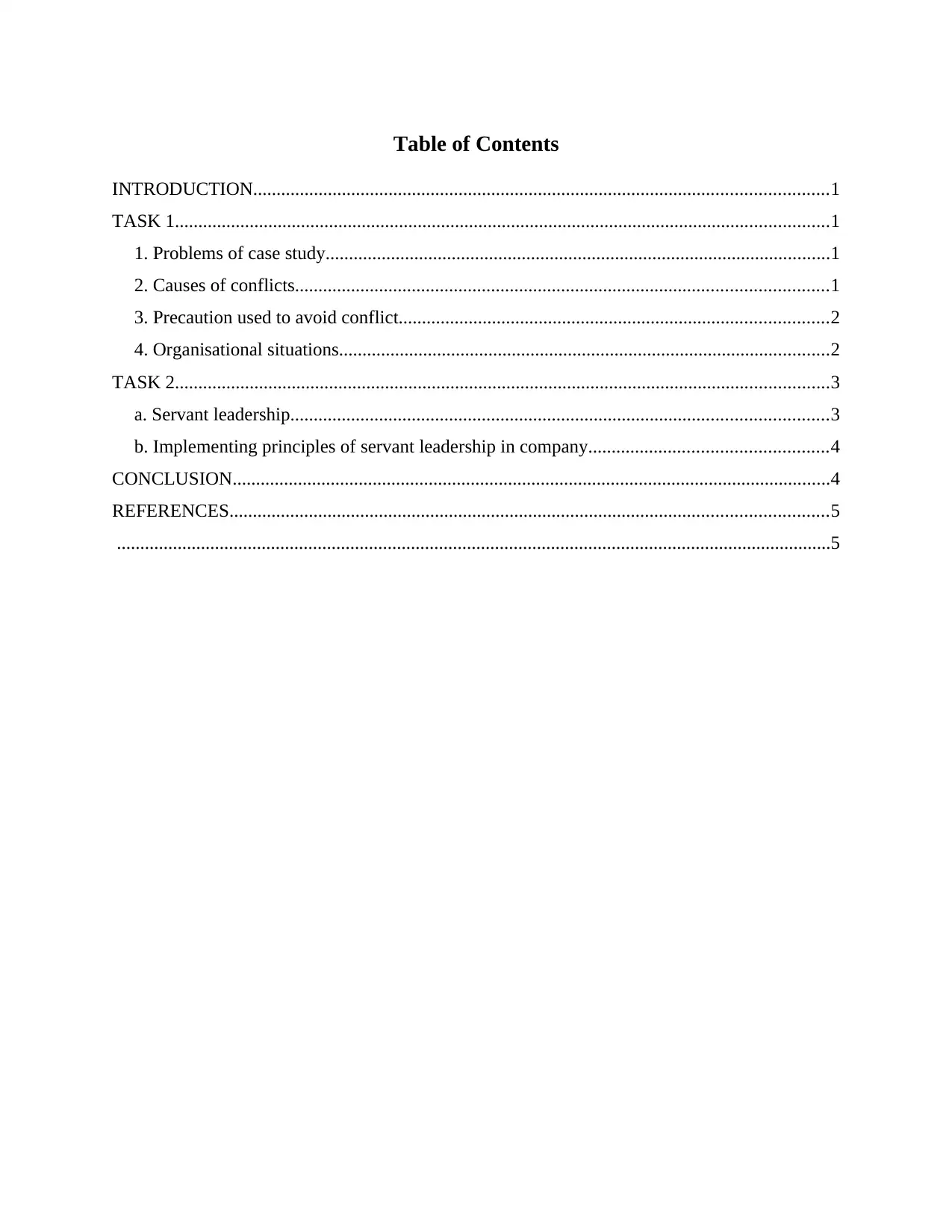
Table of Contents
INTRODUCTION...........................................................................................................................1
TASK 1............................................................................................................................................1
1. Problems of case study............................................................................................................1
2. Causes of conflicts..................................................................................................................1
3. Precaution used to avoid conflict............................................................................................2
4. Organisational situations.........................................................................................................2
TASK 2............................................................................................................................................3
a. Servant leadership...................................................................................................................3
b. Implementing principles of servant leadership in company...................................................4
CONCLUSION................................................................................................................................4
REFERENCES................................................................................................................................5
.........................................................................................................................................................5
INTRODUCTION...........................................................................................................................1
TASK 1............................................................................................................................................1
1. Problems of case study............................................................................................................1
2. Causes of conflicts..................................................................................................................1
3. Precaution used to avoid conflict............................................................................................2
4. Organisational situations.........................................................................................................2
TASK 2............................................................................................................................................3
a. Servant leadership...................................................................................................................3
b. Implementing principles of servant leadership in company...................................................4
CONCLUSION................................................................................................................................4
REFERENCES................................................................................................................................5
.........................................................................................................................................................5
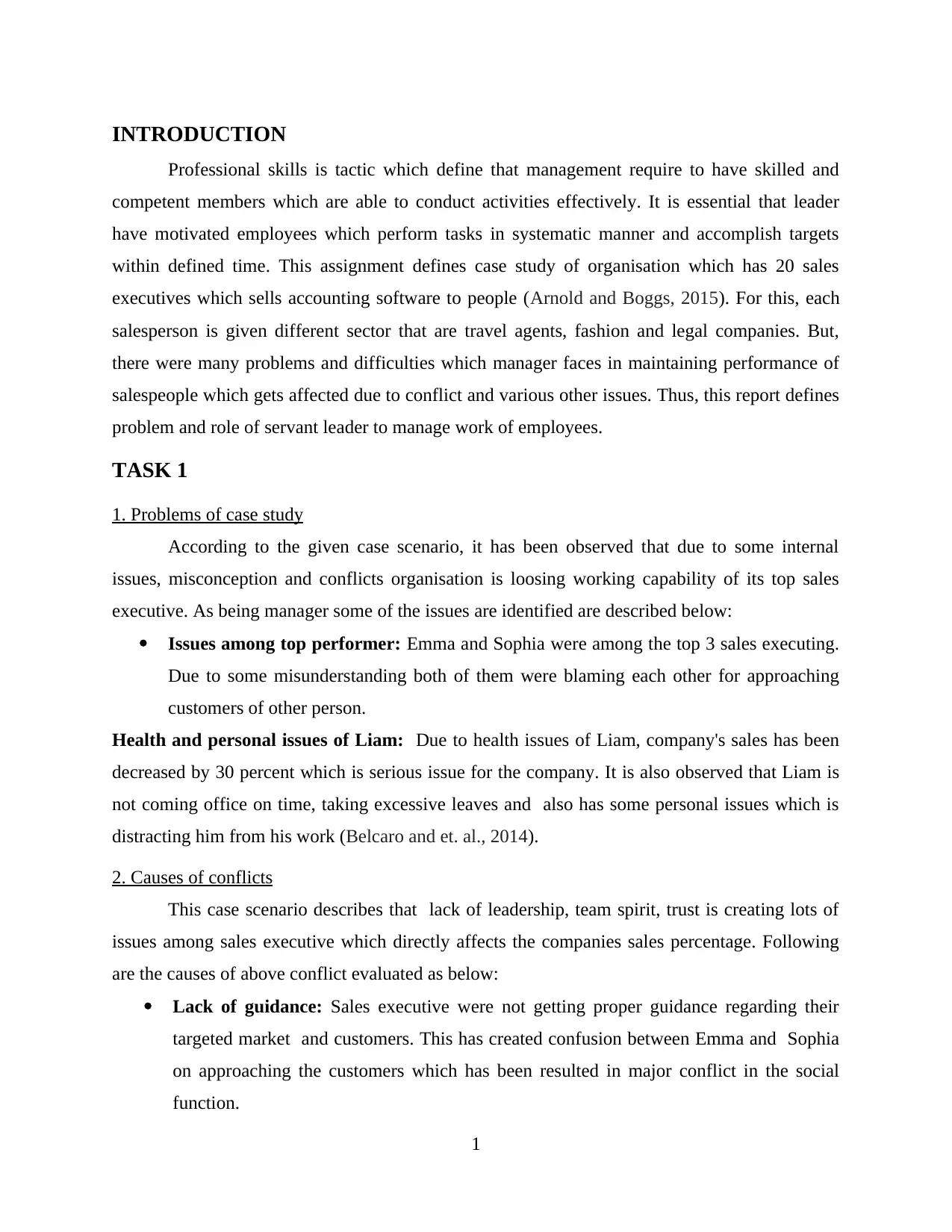
INTRODUCTION
Professional skills is tactic which define that management require to have skilled and
competent members which are able to conduct activities effectively. It is essential that leader
have motivated employees which perform tasks in systematic manner and accomplish targets
within defined time. This assignment defines case study of organisation which has 20 sales
executives which sells accounting software to people (Arnold and Boggs, 2015). For this, each
salesperson is given different sector that are travel agents, fashion and legal companies. But,
there were many problems and difficulties which manager faces in maintaining performance of
salespeople which gets affected due to conflict and various other issues. Thus, this report defines
problem and role of servant leader to manage work of employees.
TASK 1
1. Problems of case study
According to the given case scenario, it has been observed that due to some internal
issues, misconception and conflicts organisation is loosing working capability of its top sales
executive. As being manager some of the issues are identified are described below:
Issues among top performer: Emma and Sophia were among the top 3 sales executing.
Due to some misunderstanding both of them were blaming each other for approaching
customers of other person.
Health and personal issues of Liam: Due to health issues of Liam, company's sales has been
decreased by 30 percent which is serious issue for the company. It is also observed that Liam is
not coming office on time, taking excessive leaves and also has some personal issues which is
distracting him from his work (Belcaro and et. al., 2014).
2. Causes of conflicts
This case scenario describes that lack of leadership, team spirit, trust is creating lots of
issues among sales executive which directly affects the companies sales percentage. Following
are the causes of above conflict evaluated as below:
Lack of guidance: Sales executive were not getting proper guidance regarding their
targeted market and customers. This has created confusion between Emma and Sophia
on approaching the customers which has been resulted in major conflict in the social
function.
1
Professional skills is tactic which define that management require to have skilled and
competent members which are able to conduct activities effectively. It is essential that leader
have motivated employees which perform tasks in systematic manner and accomplish targets
within defined time. This assignment defines case study of organisation which has 20 sales
executives which sells accounting software to people (Arnold and Boggs, 2015). For this, each
salesperson is given different sector that are travel agents, fashion and legal companies. But,
there were many problems and difficulties which manager faces in maintaining performance of
salespeople which gets affected due to conflict and various other issues. Thus, this report defines
problem and role of servant leader to manage work of employees.
TASK 1
1. Problems of case study
According to the given case scenario, it has been observed that due to some internal
issues, misconception and conflicts organisation is loosing working capability of its top sales
executive. As being manager some of the issues are identified are described below:
Issues among top performer: Emma and Sophia were among the top 3 sales executing.
Due to some misunderstanding both of them were blaming each other for approaching
customers of other person.
Health and personal issues of Liam: Due to health issues of Liam, company's sales has been
decreased by 30 percent which is serious issue for the company. It is also observed that Liam is
not coming office on time, taking excessive leaves and also has some personal issues which is
distracting him from his work (Belcaro and et. al., 2014).
2. Causes of conflicts
This case scenario describes that lack of leadership, team spirit, trust is creating lots of
issues among sales executive which directly affects the companies sales percentage. Following
are the causes of above conflict evaluated as below:
Lack of guidance: Sales executive were not getting proper guidance regarding their
targeted market and customers. This has created confusion between Emma and Sophia
on approaching the customers which has been resulted in major conflict in the social
function.
1
⊘ This is a preview!⊘
Do you want full access?
Subscribe today to unlock all pages.

Trusted by 1+ million students worldwide
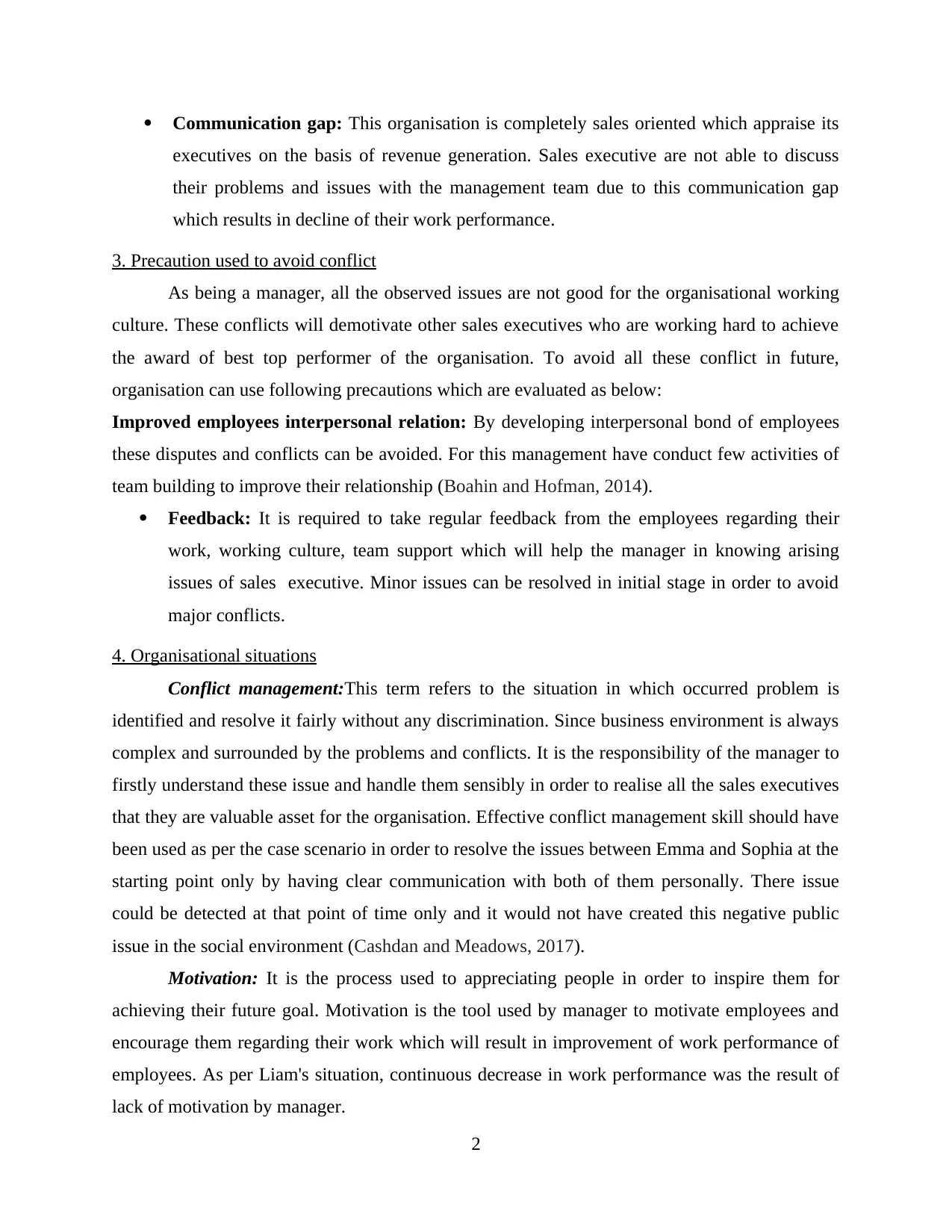
Communication gap: This organisation is completely sales oriented which appraise its
executives on the basis of revenue generation. Sales executive are not able to discuss
their problems and issues with the management team due to this communication gap
which results in decline of their work performance.
3. Precaution used to avoid conflict
As being a manager, all the observed issues are not good for the organisational working
culture. These conflicts will demotivate other sales executives who are working hard to achieve
the award of best top performer of the organisation. To avoid all these conflict in future,
organisation can use following precautions which are evaluated as below:
Improved employees interpersonal relation: By developing interpersonal bond of employees
these disputes and conflicts can be avoided. For this management have conduct few activities of
team building to improve their relationship (Boahin and Hofman, 2014).
Feedback: It is required to take regular feedback from the employees regarding their
work, working culture, team support which will help the manager in knowing arising
issues of sales executive. Minor issues can be resolved in initial stage in order to avoid
major conflicts.
4. Organisational situations
Conflict management:This term refers to the situation in which occurred problem is
identified and resolve it fairly without any discrimination. Since business environment is always
complex and surrounded by the problems and conflicts. It is the responsibility of the manager to
firstly understand these issue and handle them sensibly in order to realise all the sales executives
that they are valuable asset for the organisation. Effective conflict management skill should have
been used as per the case scenario in order to resolve the issues between Emma and Sophia at the
starting point only by having clear communication with both of them personally. There issue
could be detected at that point of time only and it would not have created this negative public
issue in the social environment (Cashdan and Meadows, 2017).
Motivation: It is the process used to appreciating people in order to inspire them for
achieving their future goal. Motivation is the tool used by manager to motivate employees and
encourage them regarding their work which will result in improvement of work performance of
employees. As per Liam's situation, continuous decrease in work performance was the result of
lack of motivation by manager.
2
executives on the basis of revenue generation. Sales executive are not able to discuss
their problems and issues with the management team due to this communication gap
which results in decline of their work performance.
3. Precaution used to avoid conflict
As being a manager, all the observed issues are not good for the organisational working
culture. These conflicts will demotivate other sales executives who are working hard to achieve
the award of best top performer of the organisation. To avoid all these conflict in future,
organisation can use following precautions which are evaluated as below:
Improved employees interpersonal relation: By developing interpersonal bond of employees
these disputes and conflicts can be avoided. For this management have conduct few activities of
team building to improve their relationship (Boahin and Hofman, 2014).
Feedback: It is required to take regular feedback from the employees regarding their
work, working culture, team support which will help the manager in knowing arising
issues of sales executive. Minor issues can be resolved in initial stage in order to avoid
major conflicts.
4. Organisational situations
Conflict management:This term refers to the situation in which occurred problem is
identified and resolve it fairly without any discrimination. Since business environment is always
complex and surrounded by the problems and conflicts. It is the responsibility of the manager to
firstly understand these issue and handle them sensibly in order to realise all the sales executives
that they are valuable asset for the organisation. Effective conflict management skill should have
been used as per the case scenario in order to resolve the issues between Emma and Sophia at the
starting point only by having clear communication with both of them personally. There issue
could be detected at that point of time only and it would not have created this negative public
issue in the social environment (Cashdan and Meadows, 2017).
Motivation: It is the process used to appreciating people in order to inspire them for
achieving their future goal. Motivation is the tool used by manager to motivate employees and
encourage them regarding their work which will result in improvement of work performance of
employees. As per Liam's situation, continuous decrease in work performance was the result of
lack of motivation by manager.
2
Paraphrase This Document
Need a fresh take? Get an instant paraphrase of this document with our AI Paraphraser
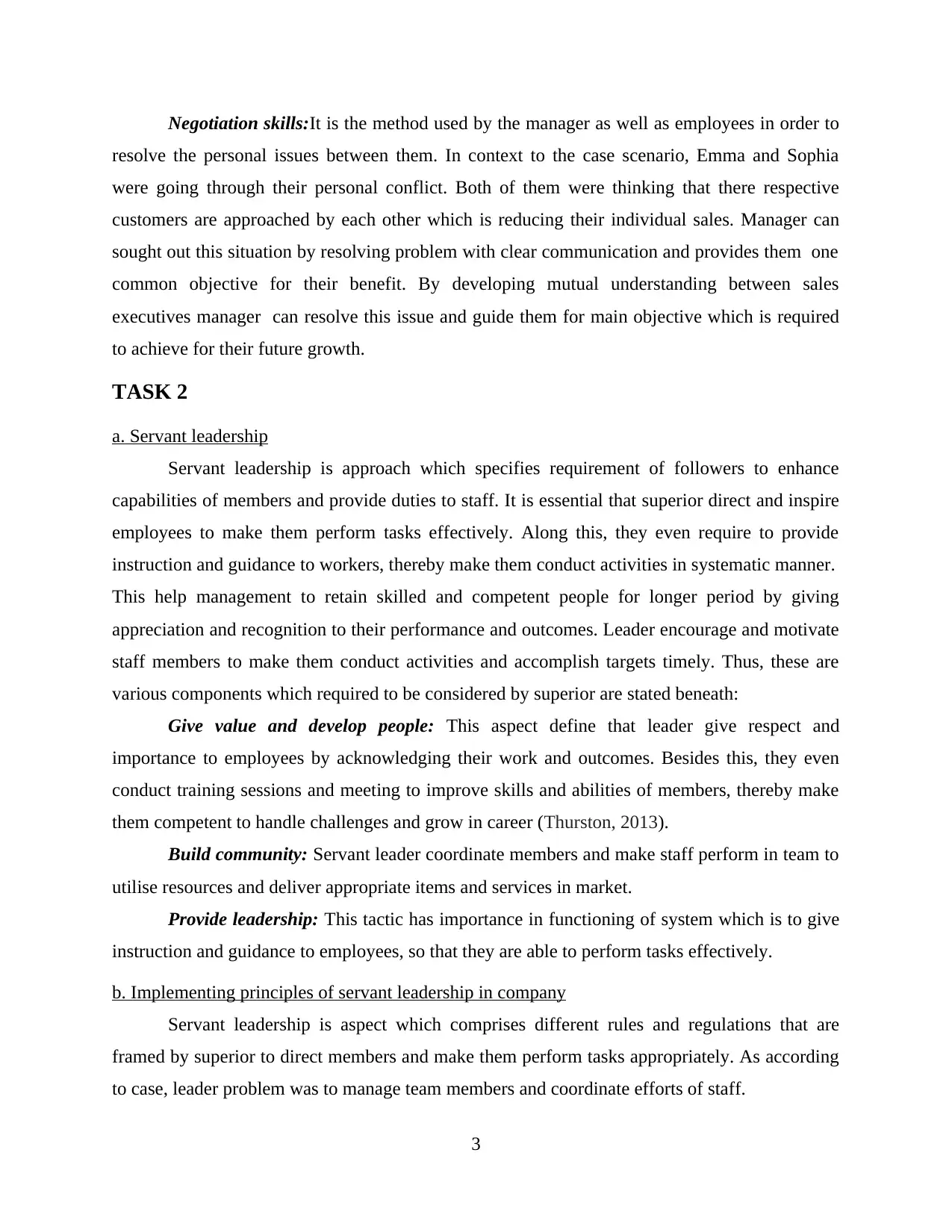
Negotiation skills:It is the method used by the manager as well as employees in order to
resolve the personal issues between them. In context to the case scenario, Emma and Sophia
were going through their personal conflict. Both of them were thinking that there respective
customers are approached by each other which is reducing their individual sales. Manager can
sought out this situation by resolving problem with clear communication and provides them one
common objective for their benefit. By developing mutual understanding between sales
executives manager can resolve this issue and guide them for main objective which is required
to achieve for their future growth.
TASK 2
a. Servant leadership
Servant leadership is approach which specifies requirement of followers to enhance
capabilities of members and provide duties to staff. It is essential that superior direct and inspire
employees to make them perform tasks effectively. Along this, they even require to provide
instruction and guidance to workers, thereby make them conduct activities in systematic manner.
This help management to retain skilled and competent people for longer period by giving
appreciation and recognition to their performance and outcomes. Leader encourage and motivate
staff members to make them conduct activities and accomplish targets timely. Thus, these are
various components which required to be considered by superior are stated beneath:
Give value and develop people: This aspect define that leader give respect and
importance to employees by acknowledging their work and outcomes. Besides this, they even
conduct training sessions and meeting to improve skills and abilities of members, thereby make
them competent to handle challenges and grow in career (Thurston, 2013).
Build community: Servant leader coordinate members and make staff perform in team to
utilise resources and deliver appropriate items and services in market.
Provide leadership: This tactic has importance in functioning of system which is to give
instruction and guidance to employees, so that they are able to perform tasks effectively.
b. Implementing principles of servant leadership in company
Servant leadership is aspect which comprises different rules and regulations that are
framed by superior to direct members and make them perform tasks appropriately. As according
to case, leader problem was to manage team members and coordinate efforts of staff.
3
resolve the personal issues between them. In context to the case scenario, Emma and Sophia
were going through their personal conflict. Both of them were thinking that there respective
customers are approached by each other which is reducing their individual sales. Manager can
sought out this situation by resolving problem with clear communication and provides them one
common objective for their benefit. By developing mutual understanding between sales
executives manager can resolve this issue and guide them for main objective which is required
to achieve for their future growth.
TASK 2
a. Servant leadership
Servant leadership is approach which specifies requirement of followers to enhance
capabilities of members and provide duties to staff. It is essential that superior direct and inspire
employees to make them perform tasks effectively. Along this, they even require to provide
instruction and guidance to workers, thereby make them conduct activities in systematic manner.
This help management to retain skilled and competent people for longer period by giving
appreciation and recognition to their performance and outcomes. Leader encourage and motivate
staff members to make them conduct activities and accomplish targets timely. Thus, these are
various components which required to be considered by superior are stated beneath:
Give value and develop people: This aspect define that leader give respect and
importance to employees by acknowledging their work and outcomes. Besides this, they even
conduct training sessions and meeting to improve skills and abilities of members, thereby make
them competent to handle challenges and grow in career (Thurston, 2013).
Build community: Servant leader coordinate members and make staff perform in team to
utilise resources and deliver appropriate items and services in market.
Provide leadership: This tactic has importance in functioning of system which is to give
instruction and guidance to employees, so that they are able to perform tasks effectively.
b. Implementing principles of servant leadership in company
Servant leadership is aspect which comprises different rules and regulations that are
framed by superior to direct members and make them perform tasks appropriately. As according
to case, leader problem was to manage team members and coordinate efforts of staff.
3
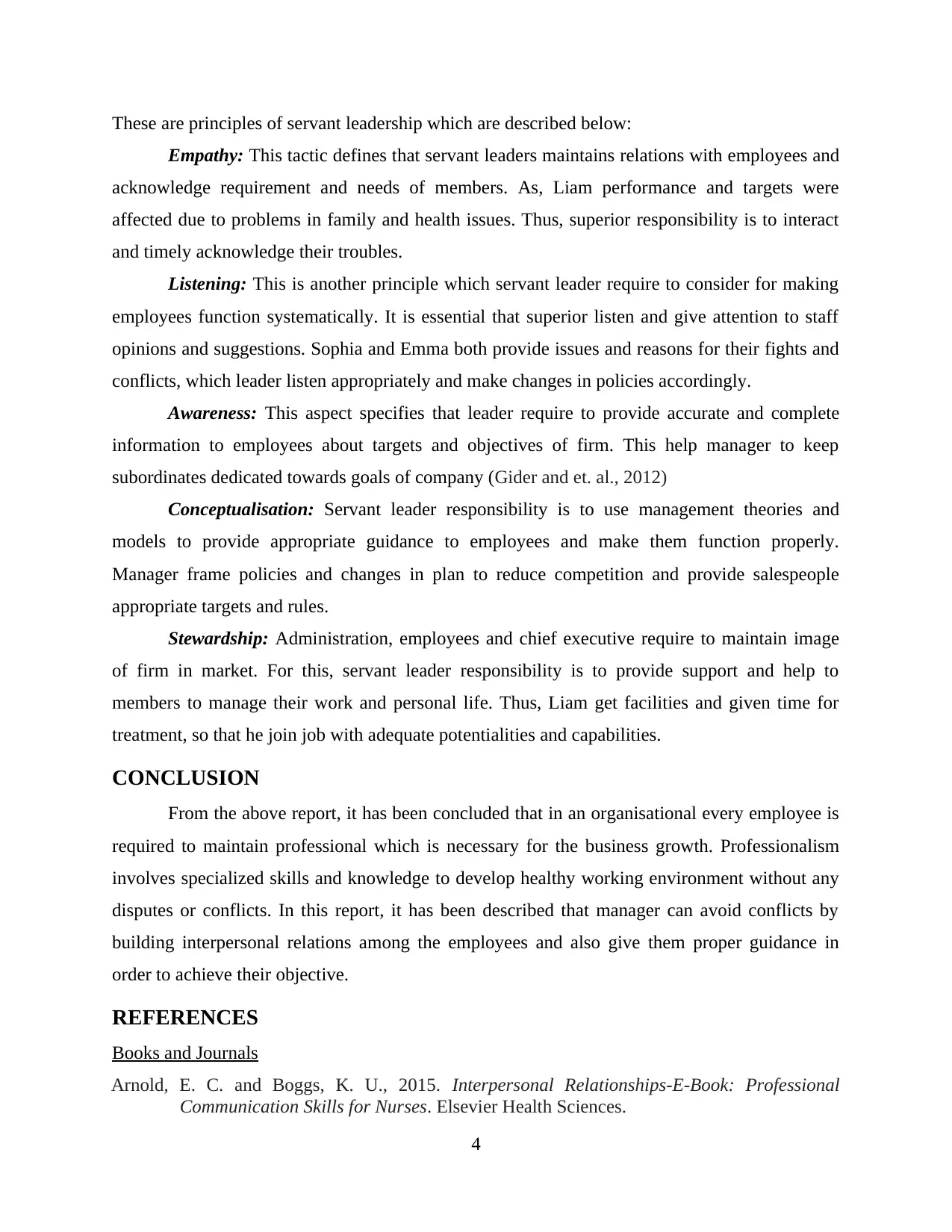
These are principles of servant leadership which are described below:
Empathy: This tactic defines that servant leaders maintains relations with employees and
acknowledge requirement and needs of members. As, Liam performance and targets were
affected due to problems in family and health issues. Thus, superior responsibility is to interact
and timely acknowledge their troubles.
Listening: This is another principle which servant leader require to consider for making
employees function systematically. It is essential that superior listen and give attention to staff
opinions and suggestions. Sophia and Emma both provide issues and reasons for their fights and
conflicts, which leader listen appropriately and make changes in policies accordingly.
Awareness: This aspect specifies that leader require to provide accurate and complete
information to employees about targets and objectives of firm. This help manager to keep
subordinates dedicated towards goals of company (Gider and et. al., 2012)
Conceptualisation: Servant leader responsibility is to use management theories and
models to provide appropriate guidance to employees and make them function properly.
Manager frame policies and changes in plan to reduce competition and provide salespeople
appropriate targets and rules.
Stewardship: Administration, employees and chief executive require to maintain image
of firm in market. For this, servant leader responsibility is to provide support and help to
members to manage their work and personal life. Thus, Liam get facilities and given time for
treatment, so that he join job with adequate potentialities and capabilities.
CONCLUSION
From the above report, it has been concluded that in an organisational every employee is
required to maintain professional which is necessary for the business growth. Professionalism
involves specialized skills and knowledge to develop healthy working environment without any
disputes or conflicts. In this report, it has been described that manager can avoid conflicts by
building interpersonal relations among the employees and also give them proper guidance in
order to achieve their objective.
REFERENCES
Books and Journals
Arnold, E. C. and Boggs, K. U., 2015. Interpersonal Relationships-E-Book: Professional
Communication Skills for Nurses. Elsevier Health Sciences.
4
Empathy: This tactic defines that servant leaders maintains relations with employees and
acknowledge requirement and needs of members. As, Liam performance and targets were
affected due to problems in family and health issues. Thus, superior responsibility is to interact
and timely acknowledge their troubles.
Listening: This is another principle which servant leader require to consider for making
employees function systematically. It is essential that superior listen and give attention to staff
opinions and suggestions. Sophia and Emma both provide issues and reasons for their fights and
conflicts, which leader listen appropriately and make changes in policies accordingly.
Awareness: This aspect specifies that leader require to provide accurate and complete
information to employees about targets and objectives of firm. This help manager to keep
subordinates dedicated towards goals of company (Gider and et. al., 2012)
Conceptualisation: Servant leader responsibility is to use management theories and
models to provide appropriate guidance to employees and make them function properly.
Manager frame policies and changes in plan to reduce competition and provide salespeople
appropriate targets and rules.
Stewardship: Administration, employees and chief executive require to maintain image
of firm in market. For this, servant leader responsibility is to provide support and help to
members to manage their work and personal life. Thus, Liam get facilities and given time for
treatment, so that he join job with adequate potentialities and capabilities.
CONCLUSION
From the above report, it has been concluded that in an organisational every employee is
required to maintain professional which is necessary for the business growth. Professionalism
involves specialized skills and knowledge to develop healthy working environment without any
disputes or conflicts. In this report, it has been described that manager can avoid conflicts by
building interpersonal relations among the employees and also give them proper guidance in
order to achieve their objective.
REFERENCES
Books and Journals
Arnold, E. C. and Boggs, K. U., 2015. Interpersonal Relationships-E-Book: Professional
Communication Skills for Nurses. Elsevier Health Sciences.
4
⊘ This is a preview!⊘
Do you want full access?
Subscribe today to unlock all pages.

Trusted by 1+ million students worldwide
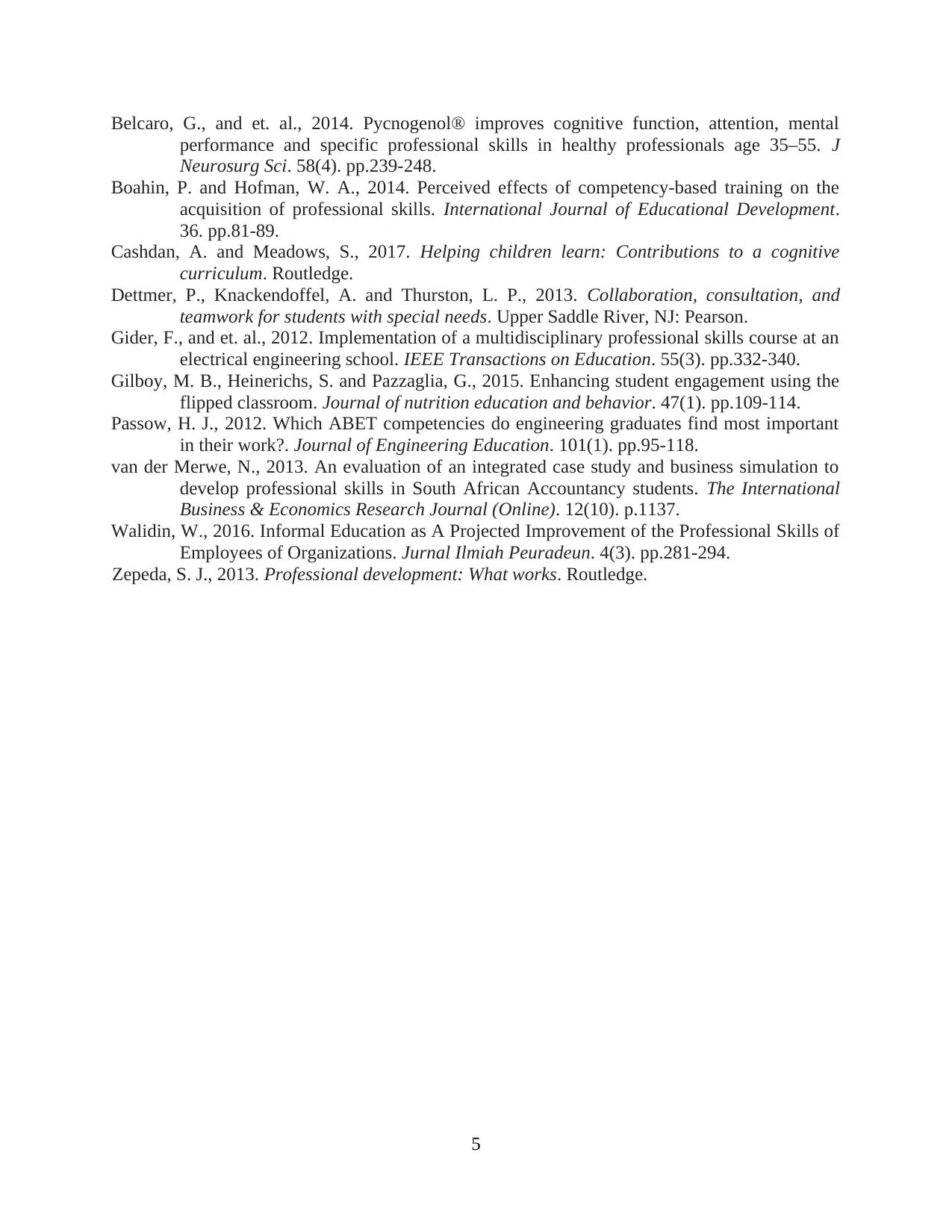
Belcaro, G., and et. al., 2014. Pycnogenol® improves cognitive function, attention, mental
performance and specific professional skills in healthy professionals age 35–55. J
Neurosurg Sci. 58(4). pp.239-248.
Boahin, P. and Hofman, W. A., 2014. Perceived effects of competency-based training on the
acquisition of professional skills. International Journal of Educational Development.
36. pp.81-89.
Cashdan, A. and Meadows, S., 2017. Helping children learn: Contributions to a cognitive
curriculum. Routledge.
Dettmer, P., Knackendoffel, A. and Thurston, L. P., 2013. Collaboration, consultation, and
teamwork for students with special needs. Upper Saddle River, NJ: Pearson.
Gider, F., and et. al., 2012. Implementation of a multidisciplinary professional skills course at an
electrical engineering school. IEEE Transactions on Education. 55(3). pp.332-340.
Gilboy, M. B., Heinerichs, S. and Pazzaglia, G., 2015. Enhancing student engagement using the
flipped classroom. Journal of nutrition education and behavior. 47(1). pp.109-114.
Passow, H. J., 2012. Which ABET competencies do engineering graduates find most important
in their work?. Journal of Engineering Education. 101(1). pp.95-118.
van der Merwe, N., 2013. An evaluation of an integrated case study and business simulation to
develop professional skills in South African Accountancy students. The International
Business & Economics Research Journal (Online). 12(10). p.1137.
Walidin, W., 2016. Informal Education as A Projected Improvement of the Professional Skills of
Employees of Organizations. Jurnal Ilmiah Peuradeun. 4(3). pp.281-294.
Zepeda, S. J., 2013. Professional development: What works. Routledge.
5
performance and specific professional skills in healthy professionals age 35–55. J
Neurosurg Sci. 58(4). pp.239-248.
Boahin, P. and Hofman, W. A., 2014. Perceived effects of competency-based training on the
acquisition of professional skills. International Journal of Educational Development.
36. pp.81-89.
Cashdan, A. and Meadows, S., 2017. Helping children learn: Contributions to a cognitive
curriculum. Routledge.
Dettmer, P., Knackendoffel, A. and Thurston, L. P., 2013. Collaboration, consultation, and
teamwork for students with special needs. Upper Saddle River, NJ: Pearson.
Gider, F., and et. al., 2012. Implementation of a multidisciplinary professional skills course at an
electrical engineering school. IEEE Transactions on Education. 55(3). pp.332-340.
Gilboy, M. B., Heinerichs, S. and Pazzaglia, G., 2015. Enhancing student engagement using the
flipped classroom. Journal of nutrition education and behavior. 47(1). pp.109-114.
Passow, H. J., 2012. Which ABET competencies do engineering graduates find most important
in their work?. Journal of Engineering Education. 101(1). pp.95-118.
van der Merwe, N., 2013. An evaluation of an integrated case study and business simulation to
develop professional skills in South African Accountancy students. The International
Business & Economics Research Journal (Online). 12(10). p.1137.
Walidin, W., 2016. Informal Education as A Projected Improvement of the Professional Skills of
Employees of Organizations. Jurnal Ilmiah Peuradeun. 4(3). pp.281-294.
Zepeda, S. J., 2013. Professional development: What works. Routledge.
5
1 out of 7
Related Documents
Your All-in-One AI-Powered Toolkit for Academic Success.
+13062052269
info@desklib.com
Available 24*7 on WhatsApp / Email
![[object Object]](/_next/static/media/star-bottom.7253800d.svg)
Unlock your academic potential
Copyright © 2020–2025 A2Z Services. All Rights Reserved. Developed and managed by ZUCOL.





